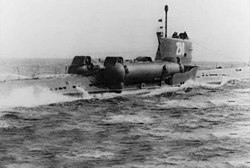S-80
|
Project 644
|
||||||||||||||||||
|
||||||||||||||||||
|
||||||||||||||||||
|
||||||||||||||||||
|
||||||||||||||||||
|
||||||||||||||||||
The S-80 was a conventionally powered submarine of Project 644, a variant of Project 613 of the Soviet Navy .
Mission history
The keel was laid on March 13, 1950 at shipyard 112 "Krasnoye Sormowo" in Gorki as a boat of the class Project 613 (NATO designation: whiskey class). It was launched on October 21, 1950 and delivered to Baku on the Caspian Sea on November 1 . After a test run in the Caspian Sea , it was transferred to the Russian Northern Fleet on the inland waterway on December 2, 1952 and remained in service there until mid-1957.
From July 1957, the S-80 was overhauled in Severodvinsk and converted to the Project 644 type (NATO designation: whiskey class, double cylinder) as a diesel attack submarine for the Soviet Navy. From April 1959 the boat was used again.
Downfall
On the night of January 26, 1961, water seeped into the diesel engines while snorkeling in the Barents Sea . There was a swell of strength 6 with a water temperature of −5 ° C. At 1:27 a.m. on January 27, 1961, the boat sank below snorkeling depth, which should have triggered an automatic closure of the snorkel to prevent further water ingress into the snorkel system. However, the de-icing system for the locking mechanism was switched off and the snorkel tube iced up.
The diesel engine immediately stopped when seawater penetrated the air supply. The machinist in the fifth section of the boat who discovered the water ingress did not close the air flap of the diesel quickly enough due to the complicated pipe routing. By the time he identified the correct handwheel, the valve stem was already bent by the mass of water entering. With the water ingress into the boat section, the boat became uncontrollable.
When the boat had reached an angle of attack of 45 °, the speed initially slowed to a standstill, then the boat sank over the stern to the seabed at a depth of 195 m. The second, third and fourth boat section collapsed, initially 24 crew members survived in the rear section of the boat. However, their attempt to leave the sunken boat with the help of the IDA-51 failed and therefore none of the 68 crew members survived the accident, their fate remained unclear for the next 7.5 years.
Recovery of the submarine wreck
The wreck was found on June 23, 1968 by the Soviet Navy salvage ship Altai at position 70 ° 1 ′ 23 ″ N , 36 ° 35 ′ 22 ″ E at a depth of 196 m and identified with her bathyscaphe as S-80 . After examining the report, a government commission ordered the recovery of the submarine wreck in Operation Depth . The Nikolayevsk SSZ shipyard built the special recovery ship Karpaty with equipment for the recovery of the submarine.
Operation Depth was carried out by a task force of the Soviet Northern Fleet, consisting of several tugs and a destroyer, under the command of the sea captain S. Minchenko. The wreck was lifted on June 9, 1969 and brought to Mys Teriberskiy in slings attached under the Karpaty . There the wreck was dumped on July 12 at a depth of 51 m on the bottom of the port of Zavalishin .
On July 24, 1969, the S-80 was lifted to the surface. In August, a government commission headed by Vice Admiral GI Schedrin examined the wreck. She not only determined the immediate cause of the downfall, but also identified two other errors that had contributed to the accident. On the one hand, the team had never attempted to take over the drive from the diesel drive to the electric drive and, on the other hand, no attempt had been made to blow out an emergency ballast tank.
See also
Web links
- Former website of submarine.id.ru - C-80 (Russian) ( Memento of May 14, 2011 in the Internet Archive )

